A close encounter with a venomous snake can be an incredibly unsettling experience, especially when it comes as a surprise. It pays to be on the lookout for vipers when out in the field during a hot Texas summer. But snakes are often well camouflaged or well concealed, even the most sharp-eyed of us can have a close call from time to time.
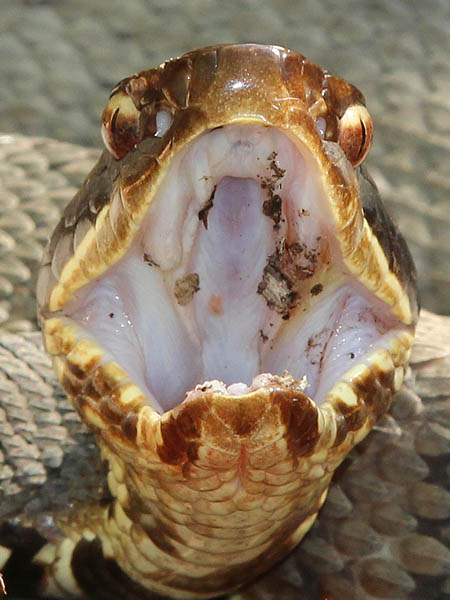
There’s something very basic about our reaction to crossing paths with a venomous snake. It’s alarming. For some people it can be very frightening. For others it is simply insulting—it’s easy to become angry when something essentially threatens to kill or injure you, no matter what the reason.
The snakes, of course, are not looking for trouble. They have very little to gain from tangling with an animal the size of a human. Mostly they just don’t want to be stepped on. If they detect you coming these snakes will generally make every effort to get out of the way. If you do get too close, they will threaten and bluster as a warning, all the while staying open for their first chance to retreat. In my experience, these snakes will strike only when surprised, approached too closely, stepped on, handled, or otherwise actively provoked.
A recent near miss with a Western Cottonmouth set me to thinking about this subject. I decided now might be a good time for a refresher course on venomous snakes in the DFW Metroplex, and what to do if bitten. Good information on the topic of first aid for snakebites can be difficult to find. There is a lot of sometimes conflicting information to be found on the internet. Old wives tales about treatments die hard. The same is true for stories about many snake behaviors.
I have tried my best to gather accurate information for this article, but I have only limited expertise on the matter. I have had a number of encounters with some species of venomous snakes, but I have never handled them. I have never been bitten, and consequently have never been treated for a snakebite. So, without the requisite intimate knowledge of these reptiles, I can only speak to what I have read and not what I have experienced. If you are not knowledgeable about snakes, then I would recommend you use this article as a starting point for doing your own research. If you are an expert on venomous snakes then I would be very glad to get your thoughts and corrections.
Below, I have listed the seven or so venomous snakes that can be found in the Dallas/Fort Worth Metroplex. They are listed in order of what I consider the likelihood that they could be encountered in our part of Texas—from most likely to least. I close by spending a little time discussing snake venom, first aid procedures, and how to protect yourself from snakebites.
Southern Copperhead (Agkistrodon contortrix contortrix) and
Broad-banded Copperhead (Agkistrodon contortrix laticinctus)
Copperheads are the most common venomous snake in our part of North Texas, by far and away. We have two varieties of these snakes in the Dallas/Fort Worth area—the Southern Copperhead, and the very similar Broad-banded Copperhead.
The two subspecies are primarily differentiated by their coloration banding. Southern Copperheads having dark bands that start wide on the snake’s belly and then narrow as they meet at the top of the snake’s back. The bands of a Broad-banded Copperhead are more uniform in width around the entire circumference of the snake. Intermediate varieties can occur in our area.
Both of these snakes have similar behaviors and can be found in similar habitats. Copperheads prefer well wooded and shaded areas. They gravitate to places where their camouflage is most effective, such as areas with abundant leaf litter and detritus. Copperheads can also make their homes in piles of wood, brush, or large stones. These snakes are most active at dawn and dusk, and are usually encountered on bike and foot trails in forested areas.
Of all the snakes listed in this post, copperheads are the ones that inflict the most bites on humans. There are a couple of reasons for this. Copperheads are very common throughout their range and they frequent habitats where people are likely to encounter them. Behaviorally, copperheads will often freeze in place when approached rather than flee. This is because these snakes are supremely confident in their camouflage, and rightfully so—these snakes can virtually disappear into the landscape.
Fortunately, the bite of this snake is usually the least serious of all those listed here. Copperheads have the least potent venom of any snake in Texas. They also have a tendency to dry bite—to inject little or no venom—when striking a non-prey animal. These factors combined with the copperhead’s small fangs (3/8 inch) help to reduce the danger presented by these snakes.
Click here to learn more about copperheads snakes in Texas.


Western Cottonmouth (Agkistrodon piscivorus leucostoma)
Western Cottonmouths—sometimes called Water Moccasins—are also very common in the North Texas area. Fortunately, these snakes usually keep to swampy locations that most people are apt to avoid. This is not always the case, however, and cottonmouths have been encountered in dry areas far from any standing body of water. Caution is always advisable when in area reported to have cottonmouths. Although these snakes account for very few bites each year, their venom is very potent. Across the United States cottonmouths are responsible for an average of about one death per year.
When encountered, Western Cottonmouths will go to great lengths to alert you to their presence in order to avoid having to bite. When alarmed or threatened these snakes will hiss loudly and open their mouths to reveal the starkly white namesake interior as a warning. They will shake the tip of their tail in in dried detritus in order to create a rattling sound. If time allows, cottonmouths will coil up, pulling their head back into the center so that only the white of their open mouth is exposed. It can be quite alarming to discover a cottonmouth behaving this way, but it is a strictly defensive posture. When given ample room, most Western Cottonmouths will retreat at the first opportunity.
Click here to read more about the Western Cottonmouth.
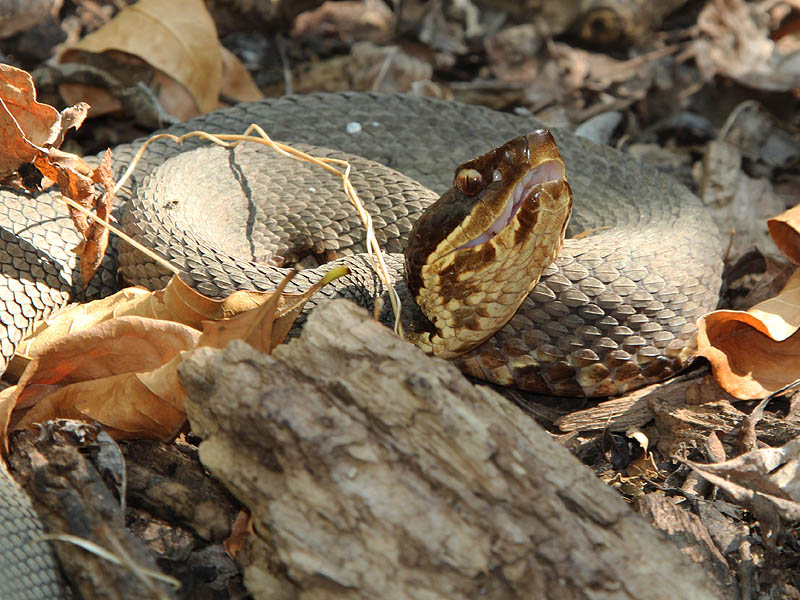
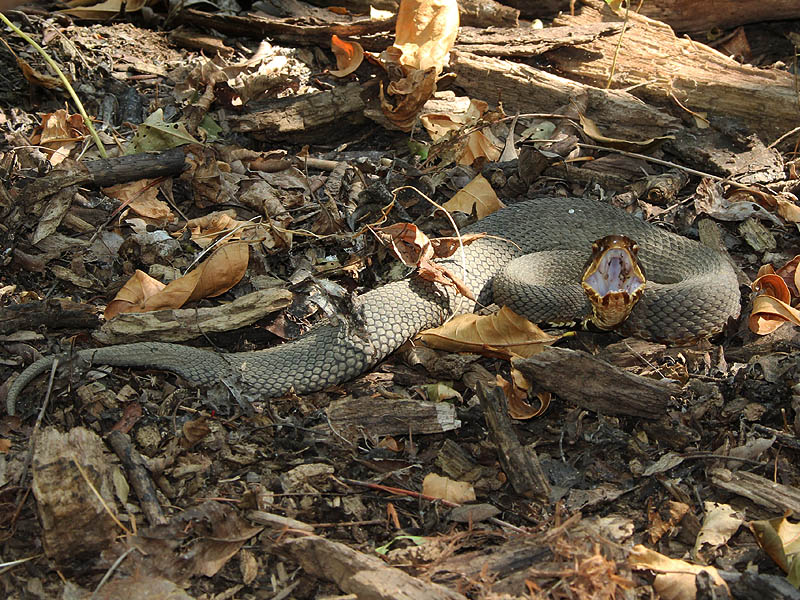
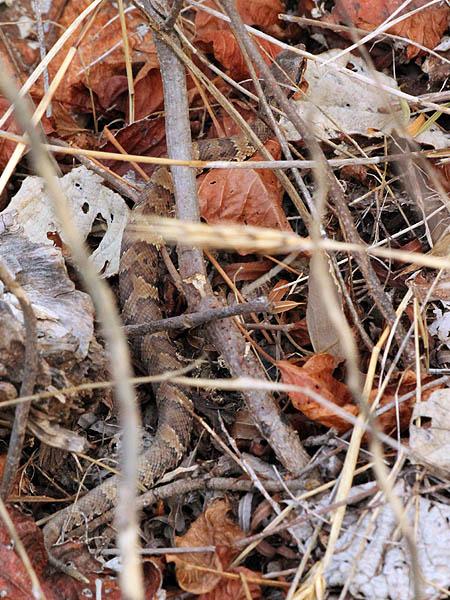
Texas Coral Snake (Micrurus tener tener)
From time to time I will get a report of a coral snake from somewhere in the metroplex. They can be common in areas near human development, but they are secretive and rarely seen. The venom of the coral snake is the most potent of all snakes in North America, and is said to be similar to that of cobras. These snakes tend to avoid confrontation with people and bites are rare—usually the result of deliberate and prolonged handling. Further, the nature of the Texas Coral Snake’s fangs makes it difficult for the snake to effectively envenomate a human. When bites do occur, they should be considered very serious. Only a small amount of coral snake venom can prove to be fatal.


Coral snakes can sometimes be confused with other similarly colored, but non venomous snakes, like the milk snake pictured to the right. The arrangement of the color bands is a good differentiator. The operative phrase to remember is, “Red touch yellow, kill a fellow. Red touch black, friend of Jack.”
Click here to for more information about the Texas Coral Snake.
Western Massasauga (Sistrurus catenatus tergeminus)
The Western Massasauga is another snake that is only very rarely seen. Preferring a habitat of native grassland and open prairie, the Western Massasauga is best adapted to the middle third of the state. The distribution of these rattlesnakes ranges into our western most counties and I have seen a few reports of encounters from southwest of Fort Worth . These snakes are said to be generally uncommon, but sometimes locally abundant.
Western Massasaugas are nocturnal and secretive—two traits that help the snake avoid confrontations with people. When bites do happen they are seldom serious. Short fangs and low potency venom makes deaths from Western Massasauga bites unlikely.
Follow this link for more information on the Western Massasauga.
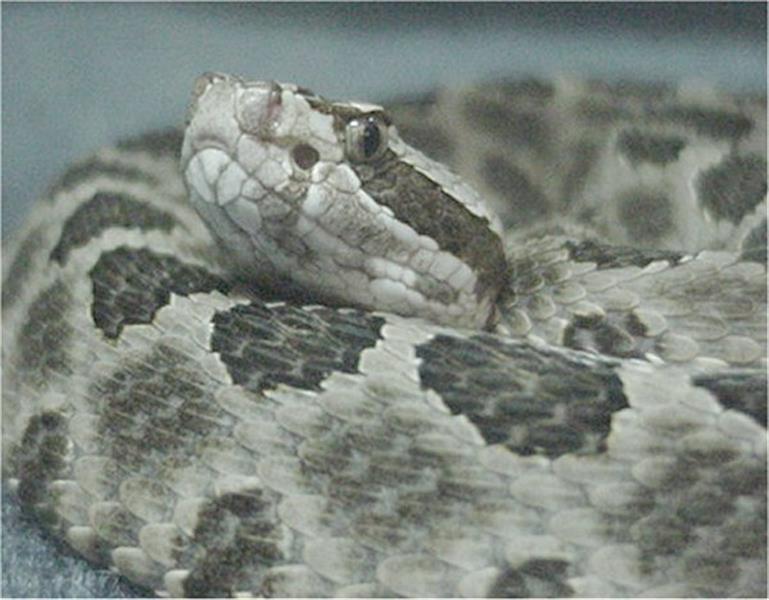
Western Pigmy Rattlesnake (Sistrurus miliarius streckeri)
Sighting of the Western Pigmy Rattlesnake usually occur far to the east of the Dallas/Fort Worth Metroplex. They frequent places with dense vegetation near reliable water sources. I have received no reports of encounters in our area, but distribution maps show that it is possible that this snake ranges into our eastern most counties.
Even though this little rattlesnake is said to be quick to bite, it is not considered very dangerous. The snake’s tiny fangs generally limit its ability to envenomate, and even with a successful bite the Western Pigmy Rattlesnake does not produce enough venom to deliver a fatal quantity.
Click here to learn more about the Western Pigmy Rattlesnake.

Western Diamondback Rattlesnake (Crotalus atrox)
The Western Diamondback Rattlesnake is perhaps the most dangerous of all the snakes on this list. It is very common across all its range, and shows no specific habitat preference. This rattlesnake is active during the day and said to be very bold. All of these factors combine to make encounters with people relatively likely.
The Western Diamondback Rattlesnake’s venom is a potent cocktail that includes neurotoxins, predigestive enzymes, and hemotoxins. This snake is responsible for the majority of serious hospital treated snakebites in Texas.
Fortunately the distribution of this snake is limited to the western two thirds of the snake. It may range into our western most counties, but I have never heard of a sighting that occurred within the Dallas/Fort Worth Metroplex.
UPDATE (8/1/2014) – I have now seen reported sightings with photographs of Western Diamondback Rattlesnake in and around Cedar Hill State Park near Joe Pool Lake.
Follow this link to read more about the Western Diamondback Rattlesnake.
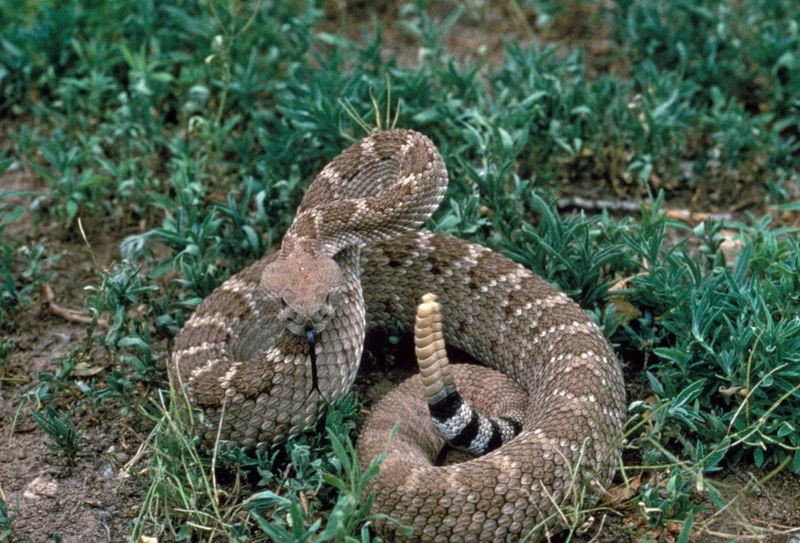
Timber Rattlesnake (Crotalus horridus)
The Timber Rattlesnake is found in the eastern third of the state of Texas. Range maps show that it may be present in the eastern most counties of the DFW Metroplex. The Timber Rattlesnake’s preferred habitat is dense underbrush in bottomland forests, and it is said to avoid developed areas. This tendency results in an uneven distribution across its range. To date, I have not heard of a sighting in, or substantially near, the Dallas/Fort Worth area.
This large snake is potentially very dangerous, but it is said to have a mild disposition and usually will provide abundant warning before striking.
Click the following link to learn more about the Timber Rattlesnake.
UPDATE (8/1/2014) – I have received reliable reports of Timber Rattlesnake sightings in northern Denton County and central Collin County near McKinney.
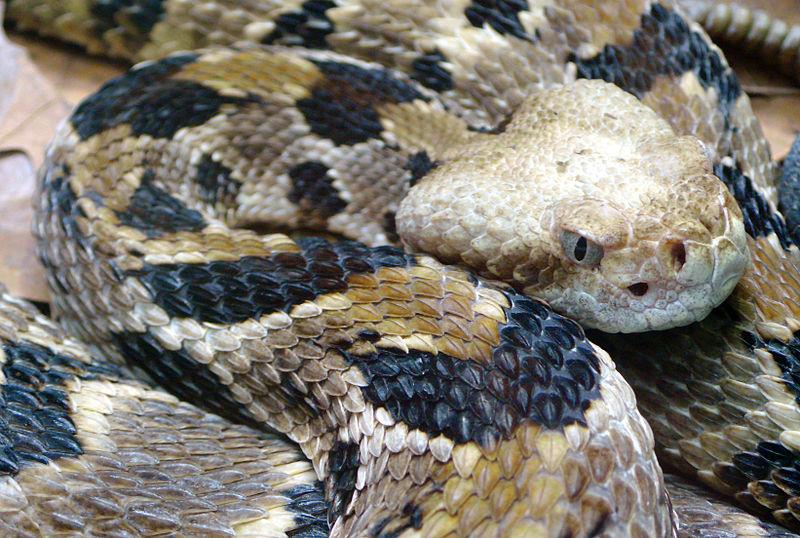
Snake Venom and First Aid
With the exception of the Texas Coral Snake all of these snakes share very similar venom. The pit vipers—copperheads, cottonmouths, and rattlesnakes all inject a kind of pre-digestive toxin. Venom from these snakes works by enzymatically breaking down the injected tissue. The effect can be quite destructive and can result in significant necrosis. You can Google pictures of bitten fingers and feet—they are not pretty. Fortunately, on large animals and people the damage is usually localized.
The immediate effects of a bite from one of these snakes can vary depending upon a number of factors. The type and size of the snake involved is important. Some snakes have more potent venom than others. Some inject a larger quantity of venom. Other factors include the size and general health of the bitten person.
A degree of pain and swelling is an almost certain after a snakebite. Nausea and respiratory distress have also been reported, and panic and anxiety might become a factor. It is not clear how debilitating these effects can be in the short term or how they might be exacerbated by physical exertion, such as hiking out of the backwoods in order to seek out treatment.
Most experts recommend that the first response to a snakebite should be to calm the victim as soon as possible. Next, all constricting clothing or jewelry in the area of the bite should be removed or loosened in case of swelling. In the field remedies such as slicing the bite site, trying to suck out the venom, or tourniquets are thought to be ineffective and possibly even harmful. The best course of action seems to be to seek out immediate medical care at the closest well supplied hospital. Fortunately, this kind of medical care should almost always be readily available in the Dallas/Fort Worth metroplex.
The venom of a Texas Coral Snake is different than that of the pit vipers. Coral snakes make use of a powerful neurotoxin that is designed to paralyze the breathing muscles and thereby suffocate its intended victim. Pain associated with a coral snakebite can be mild, and it can take up to several hours for the more serious symptoms of the neurotoxin to develop. As mentioned earlier, the venom of the Texas Coral Snake is the most potent of any snake in North America, and bites from this snake are considered very serious. Heavy does of anti-venom and artificial respiration are often required to successfully treat a coral snakebite.
Protecting Yourself
Caution is probably the most effective tool to use in preventing snakebites when out in the field. Wearing high-top boots (the higher the better) made of thick material can give you a degree of protection. Long pants with a loose fit and made of a dense weave, like denim or canvas can also help.
Move deliberately when in the field, and watch your step—especially in tall grass. Noise may help alert snakes to your approach and give them a chance to retreat before you arrive. Always double check the ground before reaching down to pick something up. Be alert for the warning hisses, rattles, and other signs that indicate a snake feels threatened. If a venomous snake is encountered, a slow steady retreat on your part is the best course of action.
More Info:
- What kind of snake it this? North Texas
- National Snakebite Support
- Snakebites: The hidden health crisis that kills 200 people a day
- So You’ve Been Envenomated By a Snake. Now What?!
Addendum – August 24, 2019
In the years since I first put this article together, I have remained very interested in the subject of venomous snakes–particularly with regards to how to respond to a snakebite in the field. To that end, I follow the National Snakebite Support Facebook Group.
The National Snakebite Support Facebook Group is monitored by a group medical professionals who have expertise treating venomous snakebites. Below are their recommendations for dealing with the immediate aftermath of a snakebite.

If you choose to join the National Snakebite Support group, please know that it is a very no-nonsense organization. The admins take their mission very seriously, and they strictly enforce the rules in order to provide the best support for emergency snakebite situations. Unless you or a family member are involved in an active snakebite, there is no reason to make posts or leave comments on this group. There is plenty to be learned by simply reading the urgent questions and following the answers provided by the medical experts.
The good news is that a venomous snakebite, when properly attended to, is rarely fatal in the United States. But that does not mean a snakebite is not a serious event. Treatment is very expensive, recovery times can’t be long, and there can be permanent damage to the affected area of the body. The bottomline… venomous snakebites are to be avoided at all costs. Be careful out there!


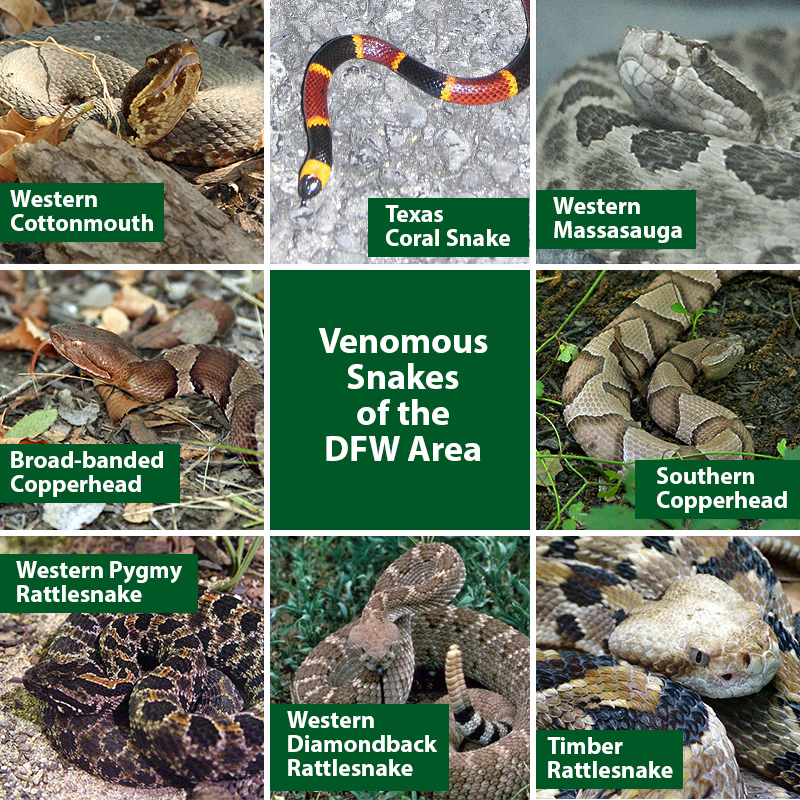
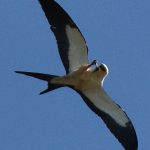

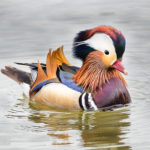
Great information!
Great information very informative, Thank You
LOVE this post, Chris. Thank you for writing it up! 🙂
Thanks for saying so, Sam! Glad to do it!
Chris,
We live in Southwest Dallas and have a live coral snake in a covered bucket. We contacted you last year when we killed one in our yard, and you said you might know someone at UNT who would like to have it. This one isn’t very big–maybe 12-18 inches–but it is alive.
Julie
Great facts
Whew! I was weeding in an overgrown part of my yard in Dallas near White Rock Lake today and heard a “rattle” in the bushes nearby. I am very relived to know it was not a rattlesnake, but I am going to ask my husband to weed that part of the yard! Thank you for the information. Lee
We just killed a coral snake this morning in far Southwest Dallas. Our neighbor killed one last week. Thank you for the info.
My dog & 2 puppies got bit by a copper head they all are ok
Wow. How did this happen, Sherry?
Thanks for sharing this information. I had a cooper head on my mantal when I woke up one morning. We were able to contain him and release him back out into the woods nearby. I have seen more in the yard but try to be careful when outdoors. I am in the unincorporated southwestern Crowley.
Pretty sure we just killed a Western Diamondback at our house in Parker County (W. Fort Worth)
Killed a newborn Western Diamond back in my yard this afternoon in Aledo. First one we’ve seen since moving here almost 3 years ago thank God.
It was in a fenced area with my chickens, that I love, almost as much as my kids (jk). It was heading to a neighbor’s house and their dogs were out so I felt i had not choice, I had to confront and kill it. I discovered that my response to terror is to cry so that is what I did while I killed the snake with a shovel from as far away as possible. Ugh morning nightmares about snakes tonight!
Just went walking through a forested park area that I had been through more then twenty times. Tonight was the first time I went later on—730 pm after the sun had set. Saw two copperheads directly in front of me on the cement trail. If I wouldn’t have seen them, I probably would have been bit. Very unnerving.
Arlington, TX
New to Texas. Found a skinny smaller size snake in my pool. Forearm in length. Medium brown. No scales. Looks like a Texas bind snake per photos I saw online but I’m not sure since those don’t seem to be native the to area. What could it be? Is it venomous?
Is the square photo montage available is high def or as a poster?
My son has pictures of a beautiful Timber Rattler he came across while hiking on the abondoned railroad land north of E. Shepherd St. in Denison, TX.
I woke recently to find a large (3feet long)dark grey snake coiled out in the open on fresh cut grass near a tree in my back yard. I confronted it with a shovel and it took off fast. I live in Rowlett, 150 yards from Lake Ray Hubbard. It’s not uncommon to find copperheads on my property; but this is rare. Water moccasin maybe?
Probably a harmless (non-venomous)water snake. In my experience, they flee as quickly as they can.